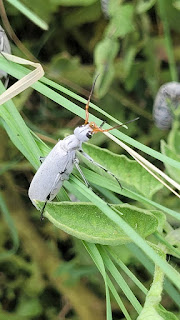Grey Blister Beetles Everywhere!
 |
| Blister Beetle - Christy Burkhard |
Blister beetles are especially concerning when they are consumed by horses after being baled in alfalfa or hay. Due to the cantharidin in their bodies, they can kill a horse if enough are consumed. In humans, the cantharidin - or blistering chemical - can take on a variety of reactions. Some people do not react, others may experience a painless fluid filled blister and other can have very severe reactions: painful blistering, immediate pain, long lasting pain.
Blister beetles are usually not a landscape pest, but in some years they will have large populations that can be found feeding on ornamentals, trees, or vegetables. This year seems to be one of those years! Across Texas (or at least Central to South), I'm receiving images of blister beetles in huge numbers on plants. In some cases, these plants are large and well established, and damage is minimal. In others, they are consuming whole tomato plants.
 |
| Blister Beetles on Tomato Plant - Christy Burkhard |
If you suspect you have blister beetles, avoid them. You never know how you might react. If they are defoliating a plant you want to save, try using a synthetic pyrethroid in either a liquid foliar spray or dust formulation. If the plant is still blooming, know that your pollinators WILL be affected, so it might be better to "wait and see". If the plant is so defoliated there are no blooms, the pollinators will not be attracted to the plant anyway and likely not encounter the pesticide... this is always a risk if blooms come out soon, but a personal decision to make - who or what is more necessary to save in your situation.
 |
| Blister Beetles feeding on tomato plant - Christy Burkhard |


Comments